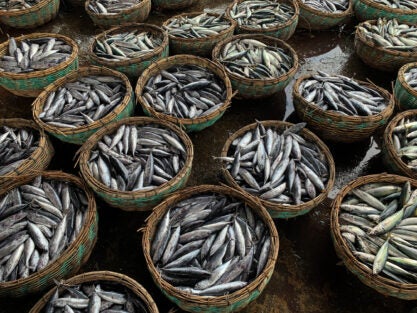February 14, 2024—With the right investments and protections, “blue foods”—seafood including fish, molluscs, and aquatic plants—can reduce hunger and improve nutrition globally, according to Harvard T.H. Chan School of Public Health’s Christopher Golden.
Golden, associate professor of nutrition and planetary health, recently spoke about blue foods on Nature’s “How to Save Humanity in 17 Goals” podcast. He also recently co-authored a study offering insights into how to protect blue foods-based food systems amid climate change.
On the February 2 podcast, Golden shared why he believes blue foods can help the world achieve United Nations Sustainable Development Goal number two, Zero Hunger. Blue foods are nutritionally richer and more environmentally sustainable than foods grown on land, he explained. Blue foods can provide essential micronutrients—such as iron, zinc, vitamins A and B12, and fatty acids—that many populations lack access to. Additionally, blue foods can wean people away from red and processed meats—a move that is better for human and planetary health alike—and can compensate for diminishing land on which to cultivate food for growing populations.
“Although blue foods have been neglected historically, because they have been viewed more as a wild food resource, farming them and creating innovative technologies to help produce aquatic foods has really been instrumental in creating healthy and sustainable diets in many regions across the world,” Golden said.
He noted that neglect of blue foods is rooted in “a kind of Western orientation” in thinking about food systems. Many countries in Africa, Asia, and the Indian and Pacific Oceans already rely heavily on blue foods—and are among the most vulnerable to food insecurity caused by warming ocean temperatures and other environmental changes.
The study Golden co-authored, published on February 5 in Proceedings of the National Academy of Sciences (PNAS), tackled the issue of access to seafood among vulnerable populations. The study examined how people in the small island state of Kiribati get their seafood. The researchers found that although people primarily buy blue foods at local markets, households with less access to markets tended to eat the most blue foods—likely because families either fish on their own or are gifted seafood by their neighbors. The findings provide new insights into how people obtain blue foods, suggesting possibilities for policy changes that could help improve households’ access to these foods through changing environmental conditions.
Listen to the Nature podcast: ‘Blue foods’ to tackle hidden hunger and improve nutrition
Read the PNAS study: Characterizing pathways of seafood access in small island developing states
Photo: iStock/Mardili Jamaluddin
